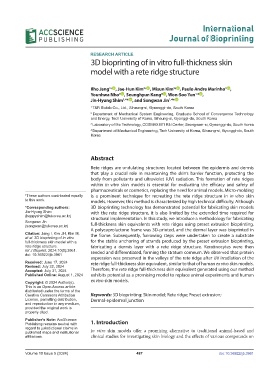Page 495 - IJB-10-5
P. 495
International
Journal of Bioprinting
RESEARCH ARTICLE
3D bioprinting of in vitro full-thickness skin
model with a rete ridge structure
Ilho Jang 1† id , Jae-Hun Kim 2† id , Misun Kim 3† id , Paulo Andre Marinho 1 id ,
Younhwa Nho 3 id , Seunghyun Kang 3 id , Won-Soo Yun 1,4 id ,
Jin-Hyung Shim * , and Songwan Jin *
1,4 id
1,4 id
1 T&R Biofab Co., Ltd., Siheung-si, Gyeonggi-do, South Korea
2 Department of Mechanical System Engineering, Graduate School of Convergence Technology
and Energy, Tech University of Korea, Siheung-si, Gyonggi-do, South Korea
3 Laboratory of Bio Technology, COSMAX BTI R&I Center, Seongnam-si, Gyeonggi-do, South Korea
4 Department of Mechanical Engineering, Tech University of Korea, Siheung-si, Gyonggi-do, South
Korea
Abstract
Rete ridges are undulating structures located between the epidermis and dermis
that play a crucial role in maintaining the skin’s barrier function, protecting the
body from pollutants and ultraviolet (UV) radiation. This formation of rete ridges
within in vitro skin models is essential for evaluating the efficacy and safety of
pharmaceuticals or cosmetics, replacing the need for animal models. Micro-molding
† These authors contributed equally is a prominent technique for recreating the rete ridge structure in in vitro skin
to this work. models. However, this method is characterized by high technical difficulty. Although
*Corresponding authors: 3D bioprinting technology has demonstrated potential for fabricating skin models
Jin-Hyung Shim with the rete ridge structure, it is also limited by the extended time required for
(happyshim@tukorea.ac.kr) structural implementation. In this study, we introduce a methodology for fabricating
Songwan Jin
(songwan@tukorea.ac.kr) full-thickness skin equivalents with rete ridges using preset extrusion bioprinting.
A polycaprolactone frame was 3D-printed, and the dermal layer was bioprinted in
Citation: Jang I, Kim JH, Kim M, the frame. Subsequently, furrowing steps were undertaken to create a substrate
et al. 3D bioprinting of in vitro
full-thickness skin model with a for the stable anchoring of strands produced by the preset extrusion bioprinting,
rete ridge structure. fabricating a dermis layer with a rete ridge structure. Keratinocytes were then
Int J Bioprint. 2024;10(5):3961. seeded and differentiated, forming the stratum corneum. We observed that protein
doi: 10.36922/ijb.3961
expression was preserved in the valleys of the rete ridge after UV irradiation of the
Received: June 17, 2024 rete ridge full-thickness skin equivalent, similar to that of human ex vivo skin models.
Revised: July 22, 2024
Accepted: July 31, 2024 Therefore, the rete ridge full-thickness skin equivalent generated using our method
Published Online: August 1, 2024 exhibits potential as a promising model to replace animal experiments and human
Copyright: © 2024 Author(s). ex vivo skin models.
This is an Open Access article
distributed under the terms of the
Creative Commons Attribution Keywords: 3D bioprinting; Skin model; Rete ridge; Preset extrusion;
License, permitting distribution, Dermal-epidermal junction
and reproduction in any medium,
provided the original work is
properly cited.
Publisher’s Note: AccScience
Publishing remains neutral with 1. Introduction
regard to jurisdictional claims in
published maps and institutional In vitro skin models offer a promising alternative to traditional animal-based and
affiliations. clinical studies for investigating skin biology and the effects of various compounds on
Volume 10 Issue 5 (2024) 487 doi: 10.36922/ijb.3961

